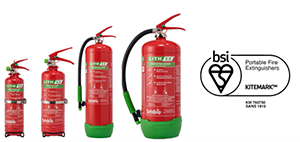

You might wonder why a regular fire extinguisher, the kind you might have in your home or workplace, cannot handle lithium-ion battery fires. SafeQuip explores why lithium-ion battery fires can be intense and tricky, unpredictable and can occur often with any warning.
Lithium-ion batteries, while highly energy-dense and efficient, can occasionally malfunction or become damaged. When this happens, a chain reaction called thermal runaway can occur, leading to a fire.
Here is a simplified explanation of how thermal runaway unfolds:
1. Trigger event: Something goes wrong with the battery, such as physical damage, overcharging, or a manufacturing defect.
2. Release of hot gases: The affected cells inside the battery swell and release hot, flammable gases.
3. Fire ignition: These gases ignite at high temperatures and can quickly spread the fire to neighbouring cells or flammable materials.
The limitations of traditional fire extinguishers
Traditional fire extinguishers are designed to combat fires by removing one or more elements of the fire triangle: heat, oxygen, and fuel. They work well for typical fires involving materials like wood, paper, or flammable liquids, where the fire triangle principles apply. However, lithium-ion battery fires are a different beast altogether. Regular extinguishers cannot quench them effectively due to the following reasons:
1. Lack of appropriate agents: Traditional fire extinguishers use agents like water, foam, or dry chemicals. These agents may not be suitable for lithium-ion battery fires because they do not address the unique challenges posed by the high-energy density of these batteries.
2. Inadequate cooling: In a lithium-ion battery fire, simply cooling the flames with water is not enough. While water can lower the temperature temporarily, the fire can reignite because it does not address the root cause – the internal reactions within the battery that sustain the fire.
3. Re-ignition risk: Even if you manage to temporarily extinguish the flames with a traditional extinguisher, there is a significant risk of re-ignition. If the battery is still compromised and the thermal runaway is not stopped, the fire can flare up again once the extinguishing agent dissipates.
4. Electrical conductivity: Many traditional extinguishing agents are conductive, which means they can cause short circuits in electronic devices like lithium-ion batteries. This could potentially worsen the situation and make it more hazardous.
The solution: Aqueous Vermiculite Dispersion (AVD)
So, if traditional fire extinguishers are not suitable for lithium-ion battery fires, what is the solution? Lith-Ex Fire Extinguishers contain Aqueous Vermiculite Dispersion (AVD). AVD is a fire extinguishing agent designed specifically to combat the unique challenges posed by lithium-ion battery fires. AVD is made from the naturally occurring mineral vermiculite combined with water. It is a very effective agent that cools, encapsulates, prevents propagation, and extinguishes lithium battery fires.
The SafeQuip Lith-Ex fire extinguisher range, which is SANS 1910-2022 approved, carries NTA 8133:2021 (KIWA/POOO55865) test approval, which proves its lithium-ion battery fire extinguishing capability.
| Tel: | +27 21 907 2500 |
| Email: | info@safequip.co.za |
| www: | www.safequip.co.za |
| Articles: | More information and articles about SafeQuip |

© Technews Publishing (Pty) Ltd. | All Rights Reserved.